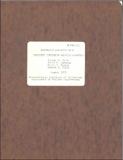| dc.contributor.author | Solan, George Michael | en_US |
| dc.contributor.author | Lanning, David D. | en_US |
| dc.contributor.author | Momsen, Bruce William Foster | en_US |
| dc.contributor.author | Pilat, E. E., 1937- | en_US |
| dc.contributor.other | Massachusetts Institute of Technology. Department of Nuclear Engineering | en_US |
| dc.date.accessioned | 2014-09-16T23:35:39Z | |
| dc.date.available | 2014-09-16T23:35:39Z | |
| dc.date.issued | 1975 | en_US |
| dc.identifier.uri | http://hdl.handle.net/1721.1/89726 | |
| dc.description | Statement of responsibility on title-page reads: George M. Solan David D. Lanning Bruce F. Momsen, and Edward E. Pilat | en_US |
| dc.description | "August 1975." | en_US |
| dc.description | Also issued as a Nucl. E. thesis, MIT Dept. of Nuclear Engineering, 1975 | en_US |
| dc.description | Includes bibliographical references (pages 271-275) | en_US |
| dc.description.abstract | A method for the neutronic analysis of plutonium recycle assemblies has been developed with emphasis on relative power distribution prediction in the boundary area of vastly different spectral regions. Such regions are those of mixed oxide (Pu0 2 in natural U02 ) fuel pins relative to enriched uranium pins, or water regions relative to fuel pin regions. The basic analytical methods for determination of spectrum averaged constants are given in the following descriptions: (1) Generalized Mixed Number Density (GMND) group constants (based on Breen's Mixed Number Density Method) are generated by a modified version of the spectrum code LASER, called LASER-M. (2) THERMOS Corrected LASER-M (TCL) group constants are based on mixed oxide- uranium oxide and water region boundary modeling in one dimensional (slab) geometry with the integral transport code THERMOS. | en_US |
| dc.description.abstract | The LASER-M model, as modified by addition of ENDF/B-II thermal cross sections for the plutonium isotopes, is used to predict the criticality of experimental lattices of U02 - 2 w/o Pu0 2, and fair agreement is shown. LASER-M unit cell depletion calculations with Yankee Core I data (3.4 w/o U-235) to 40,000 MWD/MT and Saxton Core II data (6.6 w/o Pu02 in natural U02) to 20,000 MWD/MT show good isotopic agreement. Saxton Critical Reactor Experiment (CRX) lattice cores (19 x 19 rod array) consisting of a single fuel type region (mixed oxide or uranium oxide) or multiregions of both pin types were analyzed for relative power distribution comparisons. Cores with water slot regions were included. LASER-M Normal, LASER-M GMND and TCL two group constants were used with PDQ-7 in the calculations. GMND results were in excellent agreement compared to the good agreement of TCL for these cases of isolated spectral disturbances in an asymptotic core region. | en_US |
| dc.description.abstract | The methods were applied to a proposed plutonium recycle "island design" assembly in which a large control rod water region is in close proximity to a zoned mixed oxide region. The TCL method yielded significantly greater power peaking and mixed oxide region average power owing to the spectral influence of the water region explicitly accounted for in this method. Such a result is consistent with published calculations. It is concluded that infinite lattice spectrum calculations are insufficient to deal with spectrum effects more complex than those in the Saxton CRX experiments. | en_US |
| dc.format.extent | 301 pages | en_US |
| dc.publisher | Cambridge, Mass. : Massachusetts Institute of Technology, Dept. of Nuclear Engineering, [1975] | en_US |
| dc.relation.ispartofseries | MITNE ; no. 175 | en_US |
| dc.subject.lcc | TK9008.M41 N96 no.175 | en_US |
| dc.title | Neutronic analysis of a proposed plutonium recycle assembly | en_US |
| dc.type | Technical Report | en_US |
| dc.identifier.oclc | 857062859 | en_US |
